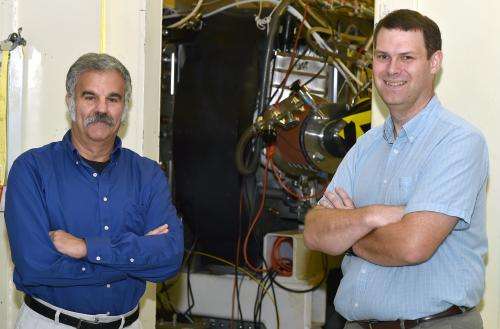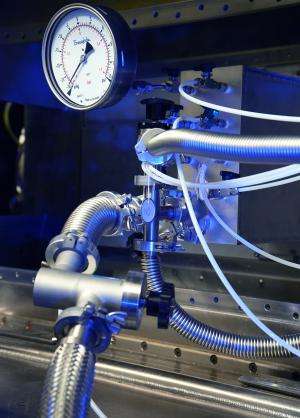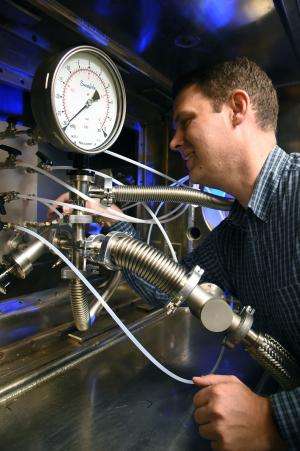Dr. John Sethian (left) and Dr. Matt Wolford (right) of the U.S. Naval Research Laboratory have partnered with a power company to see if they can reduce NOx emissions with high-energy pulses from an electron beam. "We could probably have something ready to field in about two years," says Sethian. Credit: U.S. Naval Research Laboratory/Jamie Hartman
The U.S. Naval Research Laboratory (NRL) has partnered with a power company to apply its pulsed electron beam technology to reduce the nitric oxide and nitrogen dioxide (NOx) emitted by coal power plants. "This is an opportunity for NRL to a get a technology that we developed here out in the real world," says Dr. John Sethian, the plasma physicist leading the project at NRL, "not only to show the technology works, but that NRL's contributing to cleaner energy."
The concept is to inject electron beams into the exhaust of a fossil fuel power plant and, firing them in pulses, break apart the NOx bonds. When the bonds between the nitrogen (N) and oxygen (O) atoms are ruptured, says Sethian, "They naturally want to combine into just pure nitrogen and pure oxygen, because those are the most stable substances. That's what you're breathing right now."
NRL chemist Dr. Matthew Wolford has already proven the concept works at a small scale, using a mixture of just nitrogen and NOx. Wolford's now testing with a more realistic sample. "Real flue gas," says Sethian, "may have nitrogen, carbon dioxide (CO2), oxygen, water vapor, sulfur oxide (SOx), and particulates—depending on what the coal is."
Those additional molecules complicate the chemistry. "CO2 wasn't a problem, but the oxygen threw us for a loop," says Sethian. "It's one of these up and downs, you try not to get emotionally involved." He thinks that problem is now solved, but others may arise before the team's ready to demonstrate the electron beam at a power plant. "I'm confident that we'll solve all the problems, but I can't guarantee it," he says. "I will guarantee, on the other hand, that we'll figure out what's going on."
Once the team understands the science, they'll work on optimizing the process. "There are other knobs that can be turned," says Sethian. "For example, how fast you put that energy in may matter, the temperature of the gas may matter. Putting the energy in a bunch of smaller pulses instead of one big pulse may matter." Dr. John Giuliani, who heads NRL's Radiation Hydrodynamics branch, will do some of these simulations and theoretical calculations.
The stakes for utility companies are high. The U.S. Environmental Protection Agency (EPA) has determined NOx contributes to ground-level ozone, pollution, and respiratory problems. "EPA is coming out with tighter and tighter regulations controlling NOx," says Sethian. "The current regulation is 100 parts per million and they're going to reduce that to 30 parts per million."
Today, industry uses Selective Catalytic Reduction to reduce NOx. The scrubbers are expensive to build and to operate. "There's nothing small about [Selective Catalytic Reduction]," says Sethian. Additionally, "they have to deal with a byproduct like ammonium nitrate, which is also an explosive." If NRL's technology works as expected, "We are about 10 to 20 percent of the cost of a catalytic scrubber for energy, and we don't have any byproducts."
NRL has a Cooperative Research and Development Agreement with ZerroNOx Corporation to pursue solutions for reducing NOx from coal-fired power plants and other combustion-based energy sources. Further developing the pulsed electron beam and implementing a working system is additionally supported by their parternship with a large power company.
An array of beams, each firing five times per second, breaks the NOx
Tests with power plant flue gas samples at the U.S. Naval Research Laboratory have shown high-energy electron beam pulses can break NOx apart into harmless nitrogen and oxygen. "Those are the most stable substances," says Dr. John Sethian, who leads the project. "That's what you're breathing right now." Credit: U.S. Naval Research Laboratory/Jamie Hartman
Sethian imagines splitting the exhaust into several parallel ducts, each treated with a pair of electron beams. "So you have the flue gas going along relatively slowly. You zap a section of gas, now that's now clean, and then it goes out of the system; when the next one goes in, you zap that, that's now clean, and that goes out of the system." Narrower ducts would allow the electron beam to reach all the gas more efficiently; having several systems allows for regular maintenance.
As tested at NRL, the beam works by sending a powerful pulse of electrons from a cathode through a thin foil of steel or titanium a few centimeters away. "The cathode is kept at a very high voltage; the anode is at ground, which is 0 volts," says Sethian. "The electrons accelerate from the cathode to the anode; but the anode is so thin that it doesn't stop the electrons—and they keep going, into the gas, and they deposit their energy into the gas." Firing in short pulses, Sethian says, "We can run them several times a second for very long duration runs."
Bonds typically break at 4 electron volts (eV) of energy. A simplistic way of thinking about it, he says, is, "If you have a 400,000 volt electron beam, you're breaking a 100,000 bonds with it. The electron beam is just a very efficient way of getting the bonds to break."
The beam has to be energetic enough to get through the foil and deposit energy all across the flue, but not so strong to be a serious safety hazard. "The electron beam makes x-rays when it stops in the gas," says Sethian. "The higher the voltage, the more energetic the x-rays. What we're looking for is a good, happy medium."
Electron beam originally built as Krypton Fluoride (KrF) laser for nuclear fusion
The NRL electron beam system, dubbed Electra, was originally developed as part of NRL's laser fusion program. If the electrons are fired into a KrF gas (instead of into a flue gas, as with the NOx application), they excite the molecules in the gas and produce KrF laser light. "KrF lasers have unique features," says Sethian, "such as a very smooth laser beam." This makes them ideal for driving a fusion reaction in a pea-sized pellet.
NRL's KrF laser approach may have the best potential, among the lasers that exist today, of leading to nuclear fusion. Fusing two nuclei, what powers the sun, could lead to unlimited, clean fuel on Earth; but it's a dream that's been eluding scientists around the world for over 50 years.
NRL's computer simulations predict a KrF laser could work; additionally, says Sethian, "[The laser fusion program] demonstrated, on small-scale experiments, that they can stably accelerate a section of a fusion class target to the required velocities. Most of the difficult physics is in this initial phase." They've also demonstrated the KrF laser technology can achieve the required repetition rate, durability, and efficiency.
Dr. Matt Wolford, a chemist at the U.S. Naval Research Laboratory, is investigating if an electron beam originally built for nuclear fusion research can also be used to clean up coal power plant NOx emissions. "This is an opportunity for NRL to a get a technology that we developed here out in the real world," says Dr. John Sethian, who leads the project. Credit: U.S. Naval Research Laboratory/Jamie Hartman
If NRL demonstrates the NOx system works, it makes a stronger case that the KrF laser application of the electron beam technology would have the reliability needed for a fusion energy source.
Draw it on a napkin
After making many advances with Electra while pursuing fusion research, Sethian and his team have now turned toward investigating spin-offs, like this NOx concept. "This is NRL, this is cutting edge research," he says. "We [may] have an idea, but Mother Nature doesn't always agree with all our ideas."
Sethian completed his undergraduate at Princeton and, in 1976, his PhD at Cornell University. "I am a plasma physicist by formal training," he says, "but my hobby has been restoring British cars in various forms. And I like building things."
Wolford, who's been at NRL since 2006, completed his PhD in chemistry in 2002 at the University of Pennsylvania, after an undergraduate at Binghamton University.
In all of Sethian's work, he says he's taken the approach of, "Let's assume the physics works: does this technically make sense? Draw it on a napkin. Does it look reasonable?" If you work out all the physics before the engineers are brought in, "Well, guess what, you may end up doing the wrong thing extremely well."
Achieving a system to reduce NOx emissions is a more achievable goal than nuclear fusion. It's already been drawn on a napkin and, says Sethian, "I think, if we lick the remaining physics and chemistry challenges, we could probably have something ready to field in about two years." That would mean testing at two or three power plants with portable electron beam systems; and, ultimately, offering a significant, positive impact for power companies and for all of us.
Provided by Naval Research Laboratory

























